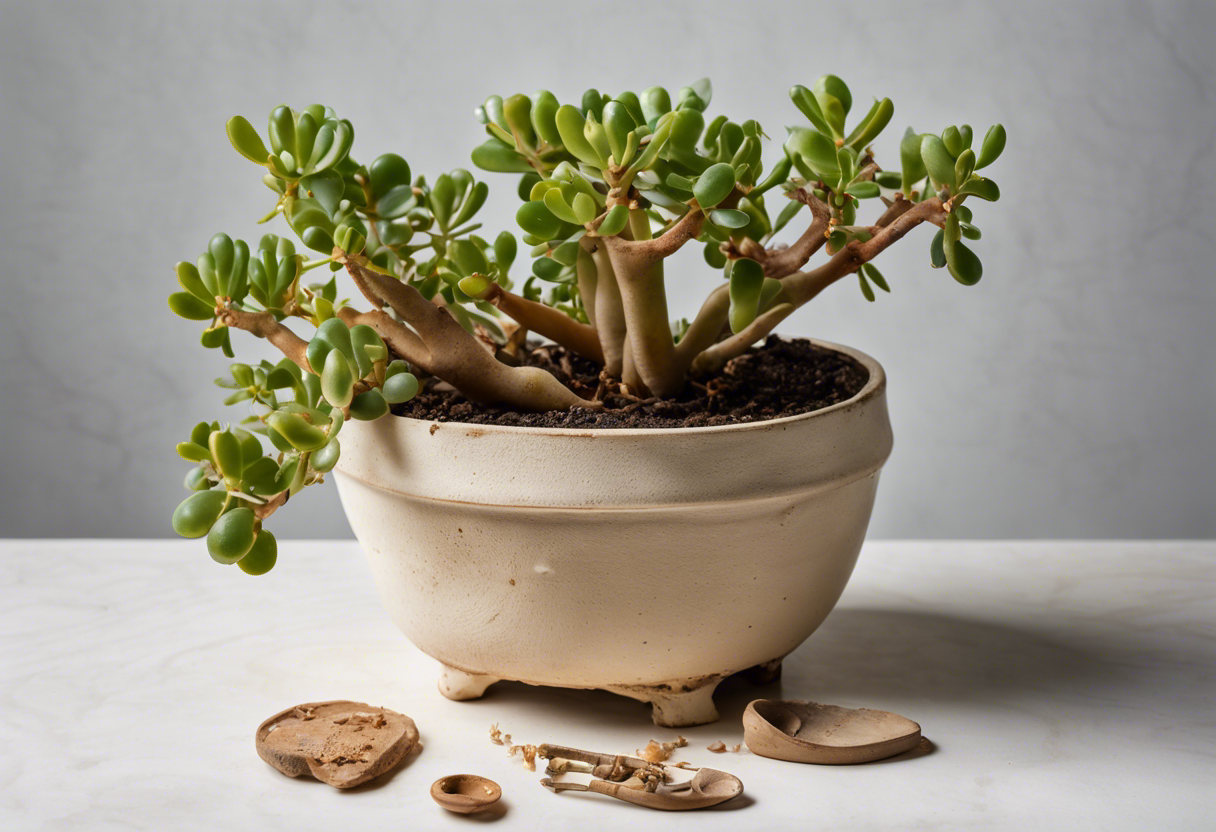Ever looked at your once vibrant jade plant, now with droopy leaves and thought, “Well, this looks like a job for Plantman!”? Well, you’re in luck. Today we’re channeling our inner Plantman and talking about How to Revive a Dying Jade Plant.
Don’t worry; you don’t need superpowers or fancy gadgets. Just a bit of knowledge, some tender love and care, and voila! Your jade plant will be back to its old self in no time. So buckle up and keep reading about how to revive a dying jade plant.
Key Takeaways
- Identify signs of a dying jade plant, such as yellowing leaves, wilting, or dropping leaves.
- Overwatering is a common cause; ensure the plant has well-draining soil and only water when the top inch of soil is dry.
- Provide adequate sunlight but avoid direct, harsh light that can burn the leaves.
- Maintain a temperature between 65 to 75 degrees Fahrenheit.
- Repot the plant if it’s root-bound or if the soil isn’t draining properly.
- Prune dead or diseased parts to promote new growth.
Understanding Jade Plants
Let’s talk about jade plants, shall we? These little green buddies are more than just a pretty face. They’re important in many ways and knowing how to revive a dying jade plant can be quite handy.
What is a Jade Plant?
A jade plant, my friends, is an adorable succulent that’s easy to love. It’s got thick, shiny leaves that look like they’ve been polished by tiny elves. People often use these beauties as indoor decorations or even as bonsai trees. That’s your basic jade plant description for ya!
But wait, there’s more! The characteristics of jade plants include their ability to store water in their leaves and stems, making them super drought-resistant. So if you’re the forgetful type who might skip watering now and then, this could be your new best friend.
And let’s not forget the uses of jade plants. Apart from being eye candy, they’re also believed to bring good luck and prosperity. So yeah, having one around could potentially make you richer…or at least happier!
The Importance of Healthy Jade Plants
Now onto why it matters to keep these leafy pals healthy. First off, healthy jade plants are simply stunning! They add a touch of greenery and nature into any space which can really lift your spirits.
But it ain’t just about looks! Healthy jade plants play a role in improving air quality too. They release oxygen and absorb carbon dioxide – pretty neat for something that doesn’t move or talk back!
The importance of plant health, especially for jades, extends beyond aesthetics and air quality though. A thriving jade plant can live for many years, becoming an enduring part of your home or office environment.
Signs of a Dying Jade Plant
Alrighty then! Now let’s get down to business: how do you know if your jade plant is in trouble? Well, there are some tell-tale symptoms of a dying jade plant to look out for.
Firstly, if the leaves start to shrivel or turn yellow, that’s a red flag. It could be due to overwatering or not enough light. Also, if you notice any black spots on the leaves or stem, it might be a sign of fungal infection.
Another key sign is weak or droopy stems. This could indicate root rot which is pretty serious stuff. So yeah, these are some ways of identifying unhealthy jade plants.
Remember folks, knowing the signs is half the battle won! The other half? Well, that would be learning how to revive a dying jade plant. But we’ll get to that later!
Causes of a Dying Jade Plant
Hey there, plant parent! If your jade plant is looking a bit under the weather, it might be due to some common jade plant problems. These can include inadequate watering, poor lighting conditions, an incorrect temperature range, or even pesky pests.
Inadequate Watering
So you’ve been either flooding your jade with love (and water) or forgetting about it in the corner. Both overwatering and underwatering can cause serious harm to your jade plant. Overwatered plants often have squishy leaves and may start to drop them like hot potatoes. On the other hand, underwatered jades will have wrinkled or shriveled leaves.
But don’t worry! It’s not too late to learn proper watering for jade plants. The key is balance – let the soil dry out between waterings and then give it a good soak. Remember, consistency is key when reviving your thirsty friend!
Poor Lighting Conditions
Just like us humans, jade plants need their beauty sleep but they also need their sunshine! Insufficient light can make them leggy and weak while excessive light can scorch their leaves.
The trick here is finding that Goldilocks zone of indoor lighting for jade plants – not too much, not too little, but just right. A bright spot with indirect sunlight usually does the trick!
Incorrect Temperature Range
Jade plants are pretty chill (pun intended), but they do have an ideal temperature range. They prefer cooler temperatures at night and warmer during the day.
If this balance isn’t met, you might start noticing some funky changes in your plant’s appearance. Don’t fret though! Adjusting your home’s thermostat or moving your plant to a different location can help meet the indoor temperature for jade plants.
Pest Infestation
Last but definitely not least on our list of causes of plant death is pest infestation. Common culprits include mealybugs and spider mites.
If you spot these unwanted guests, it’s time to take action! There are many ways to treat pest infestation in houseplants, from insecticidal soaps to neem oil. Remember, prevention is better than cure, so keep an eye out for any signs of pests!
Reviving Techniques for a Dying Jade Plant
In the quest of How to Revive a Dying Jade Plant, we’ll explore some nifty jade plant revival techniques. These include adjusting watering practices, modifying light exposure, regulating temperature, and treating pests.
Adjusting Watering Practices
Watering is crucial in jade plant care. Overwatering or underwatering can turn your jade into a sad, wilting mess. Too much water can cause root rot while too little can lead to shriveling.
The trick is finding that sweet spot in-between. The optimal watering for jade plants involves letting the soil dry out completely between waterings. Remember, these are succulents we’re talking about! They’re used to arid conditions.
Modifying Light Exposure
Next up on our list of reviving dying plants techniques is light exposure. Jade plants love sunlight but too much direct light can scorch their leaves. On the flip side, insufficient light will stunt their growth.
To ensure your jade gets adequate light, place it near a window with bright but indirect sunlight. This will satisfy its sunlight needs for succulents without turning it into a crispy critter.
Regulating Temperature
Temperature plays a big role in keeping your jade happy and healthy. These plants aren’t fans of extreme temperature fluctuations; they prefer stability.
Maintaining an ideal temperature for jade plants means keeping them in an environment that’s consistently between 65-75°F (18-24°C). Anything colder might make them think they’ve been transported to Antarctica!
Treating Pests
Finally, let’s talk about pests – every plant parent’s nightmare! Common culprits include mealybugs and spider mites which love munching on juicy jades.
For effective pest control, consider using organic methods like neem oil or insecticidal soap. Regularly inspect your plant for any signs of these uninvited guests to ensure your succulent pest treatment efforts aren’t in vain.
Preventive Measures to Keep Your Jade Plant Healthy
When it comes to maintaining jade plant health, prevention is better than cure. Regular monitoring, soil and pot selection, and appropriate fertilization are key areas that need your attention.
Regular Monitoring and Care
Regular care for jade plants involves keeping a keen eye on their overall health. You gotta watch out for signs like yellowing leaves or slow growth.
These could be the SOS signals your plant is sending out. It’s like your plant saying, “Hey buddy, I’m not feeling too good here!”
As for frequency of checking jade plants, it’s best to do a quick check every few days. This way, you can nip any problems in the bud before they get worse.
Proper Soil and Pot Selection
Choosing the right home for your jade plant is crucial. And by home, I mean the soil and pot. Jade plant soil selection can make or break its health.
A well-draining soil mix is what your jade needs to thrive. Think of it as the comfy bed where your plant gets its beauty sleep!
When it comes to pots, go for ones with good drainage too. Your jade doesn’t like wet feet! So, suitable pots for jade plants are those that prevent water logging.
Appropriate Fertilization
Just like us humans need food to stay healthy, so does your jade plant! That’s where fertilizing comes into play.
Using the best fertilizer for jade plants ensures they get all the nutrients they need. It’s like serving them a balanced diet of all things yummy!
Remember though, timing is everything when it comes to fertilizing jade plants. The best time is during their growing season – usually spring and summer.
So there you have it folks! These preventive measures are key in learning how to revive a dying Jade Plant. Keep these in mind and your jade will be as healthy as a horse!
To Wrap Up
Just like a toddler after a sugar rush, your jade plant can bounce back with a little TLC. Remember, proper watering, light conditions, and the right soil are key to its revival.
For more tips on How to Revive a Dying Jade Plant, don’t be shy! Dive deeper into our blog or join our green-thumb community. Let’s turn that black thumb green!





